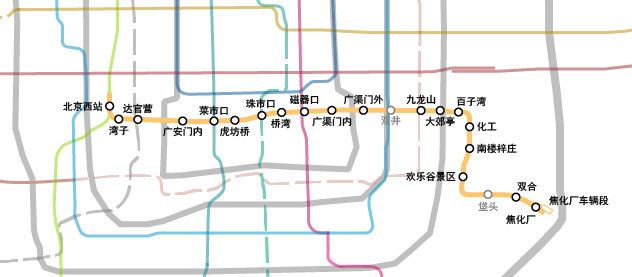Type Rapid transit Line length 23.7 km (14.7 mi) | System Beijing Subway Stations 19 | |
 | ||
Daily ridership 182,800 (2014 Avg.)
485,200 (2016 Peak) Track gauge 1,435 mm (4 ft 8 ⁄2 in) Operator Beijing Mass Transit Railway Operation Corporation Limited | ||
Line 7 of the Beijing Subway (Chinese: 北京地铁7号线; pinyin: běijīng dìtiě qīhàoxiàn) is a rapid transit rail line in Beijing. It runs parallel and to the south of Line 1 and Batong Line, from the Beijing West Railway Station in Xuanwu District to Jiaohuachang (Coking Plant) in Tongzhou District. Construction began in January 2010. It started test runs in September 2014 with full operation beginning on December 28, 2014. Like Line 6, Line 7 provides additional relief to the overcapacity Line 1 adding another east-west trunk line to the Beijing Subway network.
Contents
Route
Line 7 currently has 19 operational stations and is planned to have a total of 23 stations. The stations have longer platforms that accommodate 8-train cars, longer than existing Beijing subway station platforms which can only accommodate 6-train cars. The line was originally slated to have 17 stations, from the Beijing West Station to Baiziwan. A revised plan approved by the Planning Committee of the Beijing Municipal government called for 22 stations over 23.9 km, ending in Jiaohuachang (Coking Plant) further east. A 23rd station was added at the eastern 4th Ring Road to accommodate nearby residents.
Planning
Line 6 was originally conceived in 1973 as a "pan-handle" shaped route incorporating the central sections of today's Lines 6 and 7. In 1983 Line 6 was dissolved into two distinct lines. The section under Guang'anmen, Luomashi, Zhushikou and Guangqumen Streets and the "handle" branch to Fengtai became Line 7. The rest of the loop with a new south eastern extension to what was at the time the Beijing Jiaohuachang (Coking Plant) complex became Line 6. Line 7 was later revised westward to terminate at a new major railway station called Beijing West Railway Station and Line 9 taking over servicing Fengtai. When Beijing West Station started construction in the early 1990s space was set aside for a subway station allowing Cross-platform interchange for the future Lines 7 and 9. By 1993 the planned section of Line 6 heading to Coking Plant complex was revised as an eastern extension of Line 7, forming the alignment built today.
In 2013, planners revised the design of Line 7 from using the standard 6 car trains to 8 car trains after performing a detailed transport study of the Fatou area. Fatou's population projections were upgraded from 100,000 to 220,000 people and be a significant employment hub in the future. Planners decided that 6 cars trains would have insufficient capacity for the new demand projections. Line 7 was originally planned to use 1500V DC overhead lines to power the longer subway trains. However, the already completed platforms at Beijing West Station assumed the line would use a 750V DC 3rd rail system like Beijing's legacy subway lines and built with vertical clearance for such. The line ultimately used a 1500V DC 3rd rail system as a compromise.
Future
Construction will start on the western extension of line 7 coking plant station to a new Universal Studios theme park in 2015 with a 2019 opening date. Th extension will run primarily through Chaoyang and Tongzhou Districts. The project will add seven new stations and approximately 17 km of new line, of which 2.3 km is elevated.
Stations
List of stations from west to east.
Shuangjing Station and Fatou Station are not in operation.
